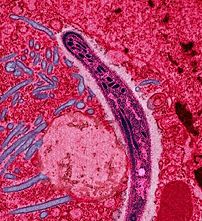
Image via Wikipedia
ATLANTA, April 2, 2009 — Radianse, Inc. today announced
that the Emergency Department (ED) of Emory University
Hospital Midtown, Atlanta, is using the Radianse real-time
location system (RTLS) with Smart Sense technology to know
early and reliably where, when and with whom patients and
staff have interacted.
According to Douglas Lowery-North, MD, vice chair of
clinical operations for the Department of Emergency Medicine
at Emory Healthcare and lead investigator of the tracking
project, Emory is in the midst of a multi-year initiative to
establish a Center of Excellence for Influenza Research and
Surveillance. The hospital is gathering and using real-time
location information to better understand and control the
spread of influenza. Researchers will then apply what
they’ve learned to create best practices across infection
control.
“Our work requires that we measure interactions among ED
patients and staff to the second and do so consistently and
without disruption to care,” says Lowery. “We use the data
in a number of ways, notably to quickly and accurately
identify and contain infectious disease.”
“Radianse immediately understood the challenge and how to
enable this use model,” said Steve Schiefen, Radianse,
“because this is precisely the level of complex problem that
Radianse Reveal is designed to help solve. To be able to
accurately and discreetly track the patient/provider
interaction is a fundamental tool for this type of research.
We built our platform and applications from the ground up to
gather sophisticated intelligence around identity, time,
location and context – intelligence that helps hospitals
improve clinical effectiveness.”
Radianse will demonstrate this and other ways to use its
RTLS for data collection, analysis and automated response at
the HIMSS 09 Annual Conference & Exhibition, in Chicago,
April 4-9, 2009, booth #3416.
Emory University Hospital Midtown’s ED staff members wear
small, Radianse active-RFID tags; patients receive a
wearable badge at admission. Behind-the-scenes, the Radianse
RTLS recognizes and records whenever patients and staff have
a “meaningful” interaction, defined by Emory and easily
programmed in the Radianse Smart Sense alerts application as
“within one meter of distance, for 30 seconds or longer.”
This real-time interaction data is combined with clinical
data: when patient diagnosis is influenza, or another
infectious disease, the hospital is able to identify and
thwart potential spread, analyze patterns of transmission
and intervene as appropriate to protect patients and the
health of employees.
Meeting healthcare standards
The Radianse active-RFID tags used by the hospital are
comfortable to wear, cleanable to stringent healthcare
standards and operate even if covered, for example, by a
patient’s hospital gown or blanket.
![Reblog this post [with Zemanta]](http://img.zemanta.com/reblog_e.png?x-id=caa4c02f-55fd-4c1e-b514-b03c00a5de32)

